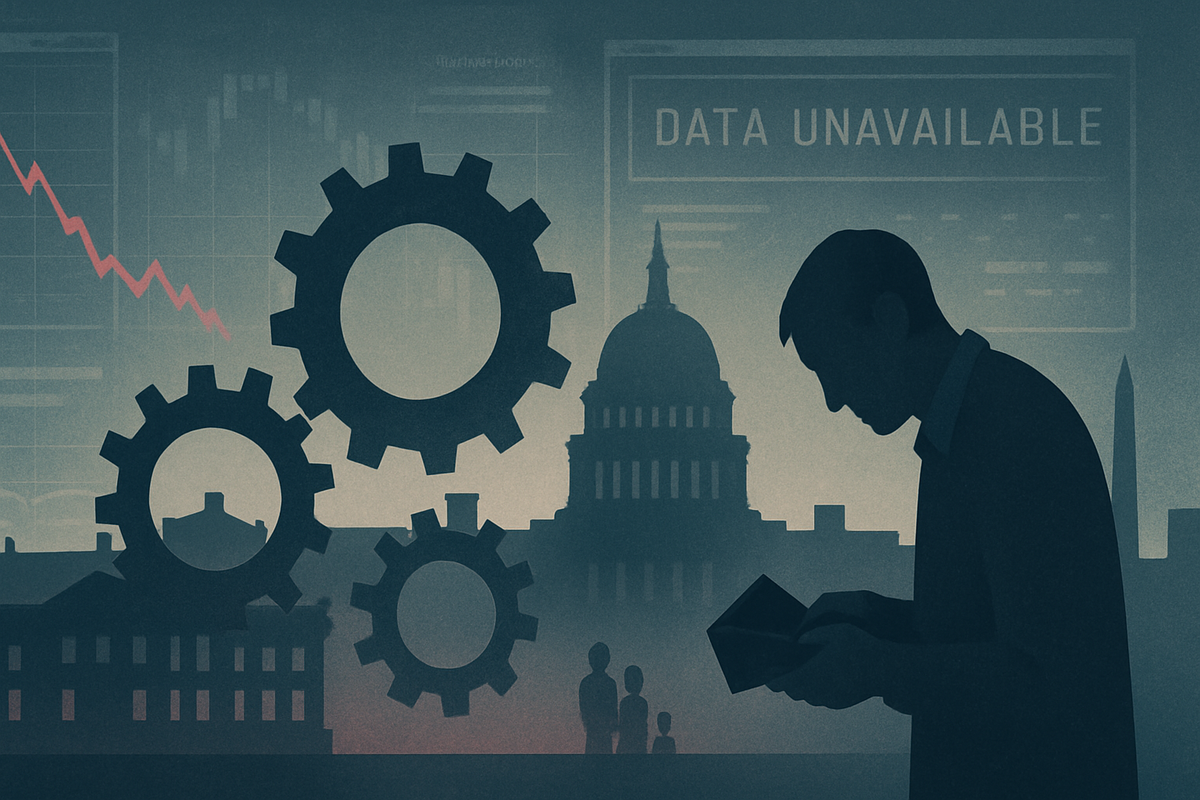
The United States economy is grappling with the deepening impact of an ongoing government shutdown, now stretching into its second week as of October 10, 2025. The stalemate in Washington has triggered an immediate information blackout, severely disrupting the release of critical economic data, and casting a long shadow of uncertainty over financial markets and business planning. Hundreds of thousands of federal employees face furloughs, while an unprecedented threat of permanent layoffs looms, intensifying concerns about consumer spending and broader economic stability.
This prolonged political gridlock is not merely a bureaucratic hiccup; it poses a significant challenge to the Federal Reserve's ability to accurately assess the nation's financial health and formulate effective monetary policy. With key economic indicators like inflation and employment reports delayed, the Fed finds itself navigating a fog of incomplete information at a time when it is reportedly considering further interest rate adjustments. The confluence of this domestic crisis with escalating global trade tensions creates a precarious economic landscape, demanding careful observation from investors and policymakers alike.
A Deep Dive into the Government Standoff: Data Disruption and Layoff Threats
The current government shutdown, which commenced on October 1, 2025, stems from an impasse over the federal budget, primarily centered on disputes regarding funding allocations for border security and social programs. Despite last-minute negotiations, Congress failed to pass appropriations bills or a continuing resolution by the September 30 deadline, triggering the partial closure of non-essential government agencies.
Key agencies vital for economic data collection, such as the Bureau of Labor Statistics (BLS), the Census Bureau, and the Bureau of Economic Analysis (BEA), have largely suspended operations. This has led to the delay of crucial reports, including the September 2025 Consumer Price Index (CPI), weekly unemployment claims, and upcoming retail sales and housing data. The preliminary Q3 GDP figures, typically released by the end of October, are also at risk. This data void leaves the Federal Reserve, analysts, and businesses without the timely insights needed to make informed decisions.
The human cost of the shutdown is substantial. Approximately 750,000 federal employees have been furloughed, meaning they are off work without pay. While a 2019 law guarantees back pay upon the shutdown's resolution, the immediate financial strain on these families is immense, forcing many to dip into savings or accrue debt. Adding a new, more severe dimension to this shutdown, the White House has announced potential "reductions in force" (RIFs) – permanent layoffs – at departments like the Treasury and Education. This unprecedented threat of permanent job losses, a departure from previous shutdowns where furloughs were temporary, has drawn strong condemnation from union leaders and signals a potentially deeper, more sustained economic drag.
Initial market reactions on October 10 reflected significant unease, with the S&P 500 (SPX) declining by 1.8%, the Dow Jones Industrial Average (DJIA) by 1.2%, and the Nasdaq Composite (IXIC) by nearly 2%. This market jitters are exacerbated by other macroeconomic pressures, particularly President Trump's recent announcement of a "massive increase" in tariffs on Chinese imports. Safe-haven assets like gold and silver have seen rallies, indicating investor flight to safety amidst the heightened uncertainty.
Companies Navigating the Storm: Winners and Losers in a Stalled Economy
The ongoing government shutdown creates a bifurcated landscape for public companies, with some facing significant headwinds and others potentially finding resilience or even opportunities. Businesses heavily reliant on federal contracts are among the most directly impacted, facing delayed payments, halted projects, and even contract terminations. While large defense contractors like Lockheed Martin (NYSE: LMT) and Boeing (NYSE: BA) have diversified revenue streams, they could still experience delays in new project approvals and payment processing. Smaller federal contractors, however, are particularly vulnerable to cash flow crises.
The tourism and travel sector is also taking a hit. With national parks and federally managed attractions closed, airlines such as Delta Air Lines (NYSE: DAL) and United Airlines (NASDAQ: UAL) could see a decrease in domestic business and leisure travel, exacerbated by potential disruptions in air traffic control. Hospitality businesses near federal sites also face reduced demand. Furthermore, the ripple effect on consumer spending from furloughed federal workers could soften sales for discretionary retailers like Macy's (NYSE: M) and Starbucks (NASDAQ: SBUX). Home improvement retailers such as Home Depot (NYSE: HD) and Lowe's (NYSE: LOW), along with homebuilders like Lennar (NYSE: LEN) and D.R. Horton (NYSE: DHI), might see reduced demand due to delayed housing starts and permits.
Sectors requiring government data or regulatory approvals face significant operational challenges. Biotech and pharmaceutical companies, for instance, could see crucial drug approvals and clinical trial reviews slow down due to minimal staffing at the FDA. The SEC's limited operations can delay Initial Public Offerings (IPOs) and merger and acquisition (M&A) reviews, impacting financial services firms like Rocket Companies (NYSE: RKT) or the mortgage division of Wells Fargo (NYSE: WFC). Similarly, energy and environmental companies could face delays in EPA permits.
Conversely, some sectors may exhibit relative resilience or even benefit. Defense contractors like Northrop Grumman Corp (NYSE: NOC), with their long-term Department of Defense contracts in essential areas, might be more insulated. Gold miners, including Newmont Corporation (NYSE: NEM) and SSR Mining (NASDAQ: SSRM), often see increased demand for their safe-haven asset during times of political and economic uncertainty. Consumer staples and utility companies, providing essential goods and services, tend to be more stable as demand remains consistent regardless of economic fluctuations.
Wider Significance: Eroding Confidence and Policy Blind Spots
The current government shutdown transcends immediate economic disruptions, embedding itself within broader industry trends and casting a long shadow over regulatory stability and international perceptions. Each week the government remains closed is estimated to shave 0.1 to 0.2 percentage points off annualized U.S. GDP growth, a figure that, while potentially recouped in part, signifies a real and immediate economic cost. The 2013 shutdown, for example, reduced Q4 GDP by 0.3 percentage points, and the 2018-2019 shutdown permanently lost an estimated $3 billion in economic output.
Beyond the direct economic hit, the shutdown creates significant ripple effects. Global supply chains face bottlenecks as U.S. customs and regulatory bodies operate with minimal staff, delaying inspections and certifications crucial for international trade. This impacts diverse sectors from agriculture to manufacturing, increasing costs and lead times for global partners. Repeated political dysfunction also erodes international confidence in the stability of U.S. governance, potentially dampening foreign investment and weakening the U.S. dollar. Competitors in industries like aerospace or technology might seize the opportunity to gain market share while U.S. counterparts face operational delays.
The regulatory implications are particularly acute. Agencies like the SEC, FDA, and EPA, operating with skeleton crews, are slowing down critical approvals for IPOs, drug trials, environmental permits, and M&A reviews. This creates significant uncertainty and delays for regulated industries, from biotech to financial services. The Committee on Foreign Investment in the United States (CFIUS) is also likely to delay new filings, extending review periods for foreign investments.
For the Federal Reserve, the shutdown presents a profound policy challenge. The "data blackout" – the suspension of crucial economic reports like the U.S. jobs report and Consumer Price Index (CPI) – leaves the central bank "flying blind." This absence of timely, comprehensive data complicates the Fed's ability to accurately assess the nation's financial health and make informed monetary policy decisions, especially when considering potential interest rate adjustments. The risk of policy missteps increases, potentially leading to either excessive tightening in a weakening economy or insufficient action in an inflationary one. This situation is particularly precarious given existing inflation concerns and global geopolitical tensions, making the current shutdown's impact potentially more severe than historical precedents where effects were often "muted" or "fleeting." The threat of permanent federal job cuts, a departure from past practice, further differentiates this shutdown, signaling a more sustained drag on the labor market.
The Road Ahead: Scenarios and Strategic Shifts
The trajectory of the U.S. economy and financial markets hinges critically on the duration and resolution of the current government shutdown. In the short term, a continued shutdown promises further GDP reduction, estimated at 0.1% to 0.2% per week, coupled with persistent market volatility. The "data blackout" will compel the Federal Reserve to operate with incomplete information, increasing the risk of policy missteps. Consumer spending will likely continue to soften as furloughed federal workers miss paychecks, and regulatory bottlenecks will persist, stalling projects and approvals across various industries.
Should the shutdown prolong, the long-term implications become more severe. Unlike previous instances where lost economic activity was largely recouped, a protracted closure, especially with the unprecedented threat of permanent federal layoffs, could lead to a lasting reduction in economic output and a sustained drag on the labor market. This erosion of public and investor confidence in governmental stability could deter foreign investment and reshape how businesses interact with federal agencies.
However, a swift resolution would likely trigger a quick market rebound, aligning with historical patterns where short-lived shutdowns have minimal lasting impact on equity performance. Furloughed workers would receive back pay, leading to a recovery in consumer spending, and delayed economic activity would largely resume. Yet, even with a quick resolution, repeated shutdowns contribute to a gradual erosion of trust in governance and fiscal stability, with agencies facing backlogs in data release and regulatory approvals for some time.
In response to this recurring instability, strategic pivots are emerging. The government itself faces pressure to reform its appropriations process to prevent future impasses. Businesses, particularly federal contractors, are increasingly looking to diversify revenue streams and reduce reliance on federal funding. Robust financial planning, including securing alternative financing, is becoming essential for weathering such periods. For investors, opportunities may arise in safe-haven assets like gold and U.S. Treasuries, or in defensive sectors and companies with strong balance sheets less exposed to federal government volatility. Conversely, challenges will persist in sectors reliant on federal permits, regulatory approvals, or direct government contracts.
Wrap-Up: Navigating Uncertainty in a Fragile Economy
The ongoing government shutdown, as of October 10, 2025, represents a significant and multi-faceted challenge to the U.S. economy and financial markets. Key takeaways highlight an immediate economic drag due to reduced government activity and furloughed federal workers, a critical "data blindness" for policymakers and investors caused by suspended economic reports, and a pervasive erosion of confidence in governmental stability. While short-term market reactions have historically been muted, the current environment—marked by the unprecedented threat of permanent federal layoffs and escalating global trade tensions—suggests potentially more profound and lasting impacts than previous shutdowns.
Moving forward, the market assessment indicates continued volatility, with investors seeking safety in assets like gold and U.S. Treasuries. Equities, while prone to short-term dips, may still demonstrate resilience if a resolution is found swiftly. However, the unique aspects of this shutdown, particularly the consideration of permanent job cuts, could introduce a more sustained drag on consumer spending and overall economic growth, making a full recovery of lost GDP less certain. The Federal Reserve's role is particularly challenging, as it navigates a "data blind" environment to make critical monetary policy decisions, potentially leaning towards more accommodative stances if economic weakness persists.
The lasting impact could extend beyond mere economic figures, affecting international perceptions of U.S. fiscal reliability and encouraging strategic shifts by businesses to reduce reliance on government processes. Investors should closely monitor the duration of the shutdown, alternative economic data sources, and crucially, the Federal Reserve's communications and actions. Watch for signs of sustained declines in consumer and business sentiment, as well as corporate earnings reports from sectors heavily exposed to government contracts or trade disputes. In these uncertain times, a cautious and diversified investment approach, coupled with a keen eye on political developments, will be paramount for navigating the months ahead.
This content is intended for informational purposes only and is not financial advice


















